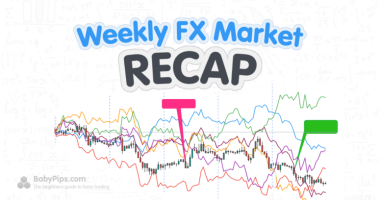The Comdolls took the top spots amidst mostly choppy price action for the FX majors, likely benefiting from early week weakness in the U.S. dollar and bond yields.
Notable News & Economic Updates:
J.P.Morgan Global Manufacturing PMI for September: 49.8 vs. 50.3 August
S&P Global PMI Commodity Price & Supply Indicators showed an uptick in cost pressures as prices rose at 1.3 times the normal speed in September
North Korea’s ballistic missile launch over Japan & crashed into the Pacific Ocean, an unprovoked launch Tuesday morning.
API reported a surprise draw of 1.770M barrels of crude oil vs. +333K forecast.
OPEC+ has decided to reduce oil production by 2 million barrels per day.
J.P.Morgan Global Services Business Activity Index came in at 50.0 in September vs. 49.3 in August
According to the EIA, U.S. Crude inventories fell 1.36M barrels last week vs. expectations of build of over 2M barrels
The United States has promised to support Ukraine in its ongoing struggle against Russia’s invasion with a fresh $625 million security assistance package.
In response to OPEC’s agreement to reduce oil production, President Joe Biden has instructed the Department of Energy to release an additional 10M barrels of oil from the Strategic Petroleum Reserve (SPR) in November.
Russian President Vladimir Putin has threatened to use tactical nuclear weapons, prompting comments from U.S. President Joe Biden that this could actually happen and bring about “Armageddon.”
U.S. firms hired more people than predicted in September, and the unemployment rate dropped to 3.5%, suggesting to a robust labor market that will keep the Fed tightening monetary policy for a while.
Intermarket Weekly Recap
It was a pretty rare sight in the financial markets this week as the U.S. dollar and bond yields took a breather from their unstoppable rallies. Unsurprisingly, we saw strength in risk assets at the same time, most notably in equities and crypto, as well as the commodity dollars. This was all despite rising concerns on the geopolitical front (escalating concerns of nuclear weapons use in Europe and missile launches from North Korea)
Arguably, this may be a potential broad market shift in the outlook on global interest rate policies, supported this week by a heavy dose of sentiment surveys showing that businesses are contractionary conditions around the world.
If economic weakness accelerates, the idea is that central banks will likely have to pause or reverse course on aggressive policy tightening. The smaller-than-expected rate hike from the Reserve Bank of Australia (hiked by 25 bps instead an expectation of 50 bps) was also a big contributor in that line of thinking this week.
But the market apparently shifted back to the norm on Wednesday as bond yields and the U.S. Dollar returned to rally mode, arguably on a combination of rising inflation fears as oil rallied had this week (likely due to OPEC+ production cuts and falling inventories).
We also saw strong employment data from the U.S., throwing a little bit of cold water on the idea of a “Fed piviot” away from aggressive monetary tightening. First the private payrolls data from ADP got the broad market rally in risk assets slowing, and then it was the better-than-expected U.S. Non-farm payrolls data on Friday that had traders locking in another big rate hike ahead. This is where we saw the big momentum move of the as risk assets fell hard into the Friday close.
Fortunately for comdoll bulls, the end-of-week dip wasn’t enough to break the early leads taken by the Loonie, Aussie, and Kiwi, with the Canadian dollar understandably taking the top spot this week as oil prices rallied over 16% since the Monday open.
USD Pairs

Overlay of USD Pairs: 1-Hour Forex Chart
S&P Global U.S. Manufacturing PMI in September: 52.0 vs. 51.5 in August
ISM Manufacturing PMI in September: 50.9 vs. 52.8 in August
John Williams, president of the Federal Reserve Bank of New York, said Monday that while there are signs of falling inflation, underlying price pressures remain too high, therefore the U.S. central bank must act to limit inflation.
JOLTS U.S. job openings fell to 10.05M in August vs. 11.17M openings in July
U.S. Factory Orders decreased by less than $100M in August and remained essentially steady at $548.4B, according to figures released by the US Census Bureau on Tuesday.
According to data from ADP, U.S.business payrolls increased by 208K last month after an upwardly revised 185K gain in August and 200K forecast
S&P Global U.S. Services PMI for September: 49.3 vs. 43.7 in August; ISM Services PMI for September: 56.7 vs. 56.9 in August; Prices index fell -2.8 to 68.7
The U.S. 30-yr fixed mortgage rate increased to 6.75%, a 16-year high, causing the greatest decline in house loan applications (-14% last week) since the pandemic’s height.
The U.S. goods and services deficit in August was $67.4B, down $3.1B from the revised $70.5B in July.
U.S. weekly jobless claims rose by 29K to 219K; continuing claims rise 15K to 1.361M
President of the Federal Reserve Bank of Cleveland Loretta Mester stated that the US central bank still needs to do more to control inflation and that she has not seen sufficient evidence to persuade her that the policymakers should slow the rate at which interest rates are raised.
U.S. Non-farm payrolls increase +263K in September vs. +315K in August; the unemployment rate fell to 3.5% from 3.7%
GBP Pairs
After less than a month in office, British Prime Minister Liz Truss was compelled to make an embarrassing U-turn on Monday, turning back a cut to the highest rate of income tax that contributed to market volatility and backlash within her party.
U.K. Manufacturing PMI for September: 48.4 vs. 47.3; price pressures remain and new orders continue to fall
U.K. Construction PMI came in higher in September at 52.3 vs. 49.2 in August
S&P Global U.K. Services PMI for September: 50.0 vs. 50.9 in August
Deputy Governor Dave Ramsden stated that the Bank of England must adhere to its plan in order to stop the inflation rise, even if it causes the British economy more harm. He also noted that the new government’s tax cuts may make the inflation problem worse.
EUR Pairs

Overlay of EUR Pairs: 1-Hour Forex Chart
S&P Global / BME Germany Manufacturing PMI: 47.8 in September vs. 49.1 in August
S&P Global Eurozone Manufacturing PMI for September: 48.4 vs. 49.6 in August; With the exception of Ireland, all Eurozone countries are showing contractionary conditions
Industrial producer prices were up by +5.0% in the euro area & by +4.9% in the EU; Up by 43.3% y/y in the euro area and by 43.0% y/y in the EU
According to ECB policymaker Francois Villeroy de Galhau, the bank will raise interest rates as much as necessary to reduce core inflation, though the rate of increase may moderate after the year’s end.
In an apparent allusion to lowering interest rates back to “neutral” zone, ECB President Christine Lagarde stated on Tuesday that the bank must at a “minimum” stop boosting the economy through its monetary policy.
Germany trade balance narrowed from 3.4B EUR in July to 1.2B EUR in august (4.8B EUR forecast)
Eurozone Services Business Activity Index for September: 48.8 (a 19-month low) vs. 49.8 in August
S&P Global Germany Services PMI fell to 45.0 in September (a 28-month low) vs. 47.7 in August
According to Destatis, German manufacturing new orders fell by 2.4% m/m in August after rising by a corrected 1.9% m/m in July.
German industrial production slipped by -0.8% m/m vs. -0.3% previous; German retail sales fell by -1.3% m/m in August vs. +0.7% m/m in July
CHF Pairs

Overlay of CHF Pairs: 1-Hour Forex Chart
Swiss consumer prices fell by -0.2% m/m vs. a projected 0.1% m/m uptick
Swiss Manufacturing PMI rose to 57.1 in September vs. 56.4 previous
Following its most recent 75-basis-point increase, the Swiss National Bank is willing to increase interest rates even more to combat inflation, according to Andrea Maechler, a member of the SNB Governing Board.
The Swiss unemployment rate declined from 2% in August 2022 to 1.9% in September. 89,526 jobless were registered at the end of September 2022, 1,846 fewer than the previous month.
Preliminary statistics calculated using IMF criteria revealed that the SNB likely held around 807B Swiss francs ($815B) in foreign currency at the end of September, down from 859B francs in August, which was lowered from an initially reported 859B.
CAD Pairs

Overlay of CAD Pairs: 1-Hour Forex Chart
S&P Global Canada Manufacturing PMI: 49.8 in September vs. 48.7 in August
In August, Canada’s total value of building permits rose 11.9% to $12.5B. Residential spending increased by 12.0% to $8.4B, while non-residential spending increased by 11.8% to $4.0B
Canada’s merchandise exports fell 2.9% in August, primarily as a result of weaker shipments of energy items. Canadian merchandise trade surplus decreased from $2.4B in July to $1.5B in August as a result.
In line with expectations, Canada gained a net 21,100 jobs in September, largely part-time jobs, according to Statistics Canada. The unemployment rate decreased to 5.2% vs. expectations of staying at 5.4%
NZD Pairs
42% of business in New Zealand surveyed expected general business conditions to worsen, compared to 65% in the previous quarter, according to the New Zealand Institute of Economic Research’s quarterly survey of business opinion (QSBO).
According to CoreLogic New Zealand, NZ house prices saw a 4.1% quarterly loss, only slightly smaller than the 4.4% dip that followed the world financial crisis 14 years ago. Prices decreased for a sixth month in a row, slowing by 1.5% m/m after dropping by 1.8% m/m in August
Global dairy prices settle down by -3.5% to $3.911 in latest GDT auction
The Reserve Bank of New Zealand hiked interest rates by 50 bps to 3.50% as expected
According to Deputy Prime Minister Grant Robertson, New Zealand can avoid a recession even in the midst of a global slowdown and as the country’s central bank continues to aggressively tighten policy in order to decrease inflation.
New Zealand Commodity Price Index for September: -0.5% vs. -3.4% previous
AUD Pairs
Australia’s MI inflation gauge rebounded by 0.5% after previous 0.5% dip
The S&P Global Australia Manufacturing PMI for September: 53.5 vs. 53.8 in August.
Australia building approvals surge 28.1% in Aug vs. 5% expected
RBA surprisingly slows rate hike from 50bps to 25bps in Oct.; RBA still expects more rate hikes over the period ahead, size and timing to depend on data
The weekly Australia consumer confidence survey fell by 2.6% w/w to 85.5
ANZ Australian job ads down by 0.5% in Sept
According to the Australian Bureau of Statistics, the August trade balance was A$8.32B, lower than expected ($10.10B) and previous month’s read of $8.73B.
RBA Financial Stability Review for October 2022: The RBA sees that stability risks have risen as global financial conditions have tightened and inflation remains persistent.
JPY Pairs

Overlay of Inverted JPY Pairs: 1-Hour Forex Chart
Japanese Tankan manufacturing index dipped from 9 to 8 vs. consensus at 11; non-manufacturing index up from 13 to 14
Bank of Japan Summary of Opinions for September: Core consumer inflation in Japan is anticipated to climb broadly and at a faster pace by the end of year.
Japan Manufacturing PMI in September: 50.8 vs. 51.5 in August; the lowest level since January 2021.
Tokyo’s core CPI accelerated from 2.6% to 2.8% from a year ago in Sept
au Jibun Bank Japan Services PMI for September: 52.2 vs. 49.5 in August
Japanese average cash earnings accelerated from 1.3% y/y to 1.7% y/y; household spending accelerated as well by 5.1% y/y vs. 3.4% y/y rate previous











